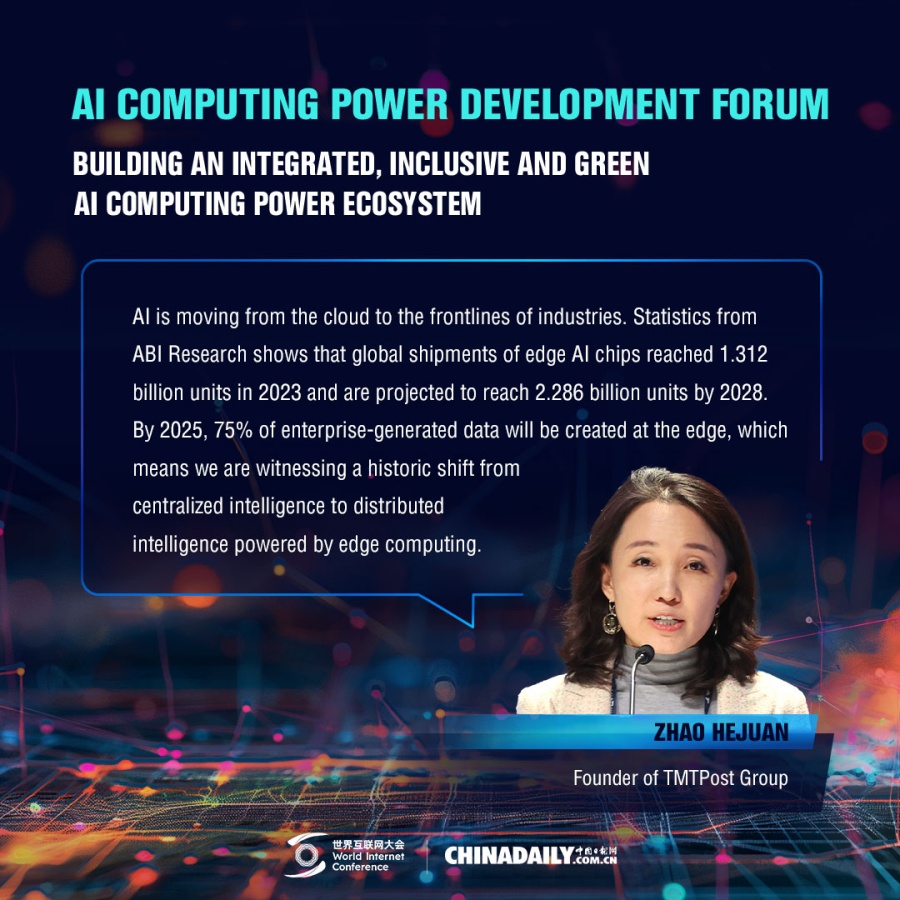
- Home
- Media Center
- Events
- Membership
- Digital Academy
-
Reports
- Collection of cases on Jointly Building a Community with a Shared Future in Cyberspace
- Collection of Shortlisted Achievements of World Internet Conference Awards for Pioneering Science and Technology
- Reports on Artificial Intelligence
- Reports on Cross — Border Ecommerce
- Reports on Data
- Outcomes of Think Tank Cooperation Program
- Series on Sovereignty in Cyberspace Theory and Practice
- Other Achievements
- About WIC
- 中文 | EN

AI Computing Power Development Forum|Zhao Hejuan: A historic transition from centralized to distributed intelligence

[Photo/wicinternet.org]
AI is moving from centralized cloud-based models to real-world industrial applications. According to ABI Research, global shipments of edge AI chips reached about 1.31 billion units in 2023 and are expected to rise to nearly 2.29 billion units by 2028. By 2025, 75 percent of enterprise data will be generated at the edge.
This marks a historic transition from centralized intelligence to distributed intelligence, said Zhao Hejuan, founder and CEO of TMTPOST Group, at the AI Computing Power Development Forum. Under the theme of “Building an Integrated, Inclusive, and Green AI Computing Ecosystem”, the event was hosted by the World Internet Conference during the 2025 Mobile World Congress in Barcelona, Spain, on March 4.
To maximize the industrial value of edge AI, Zhao emphasized the need for three key pillars: a data flywheel ecosystem, cross-domain technology integration, and industry-wide collaboration.
Through the device-edge-cloud collaborative architecture, and the integration and innovation of AI, 5G, and the Internet of Things, the cost of on-device AI deployment can be greatly reduced, development efficiency improved, and industrial intelligence promoted, she noted.
According to Gartner forecast, by 2027, 80 percent of Chinese enterprises will adopt multi-model generative AI strategies to balance functionality and local deployment needs. The International Data Corporation further predicts that AI will contribute $19.9 trillion to global GDP by 2030, with edge computing playing a pivotal role.
As AI computing power extends to the farthest edges of industry, we are witnessing not just an efficiency revolution, but a fundamental upgrade in human productivity, Zhao concluded.

The World Internet Conference (WIC) was established as an international organization on July 12, 2022, headquartered in Beijing, China. It was jointly initiated by Global System for Mobile Communication Association (GSMA), National Computer Network Emergency Response Technical Team/Coordination Center of China (CNCERT), China Internet Network Information Center (CNNIC), Alibaba Group, Tencent, and Zhijiang Lab.





